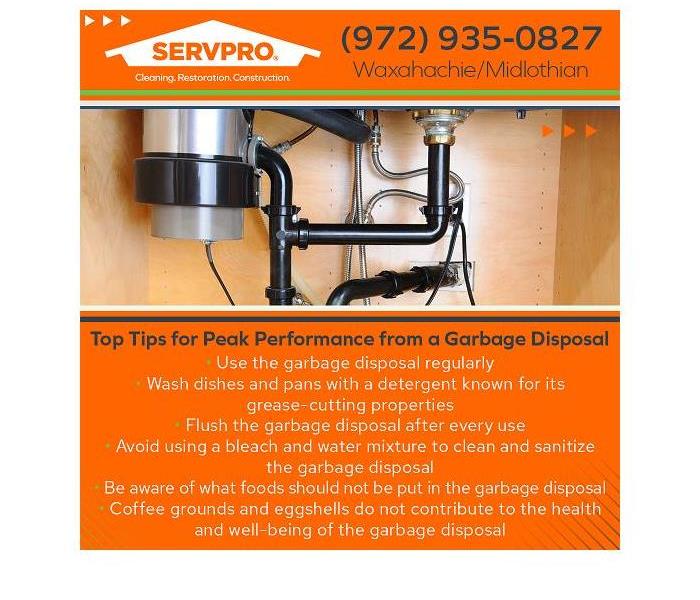How a Leaking Garbage Disposal Can Create a Water Damage Risk and What to Do About It
5/23/2022 (Permalink)
Blog Summary: SERVPRO of Waxahachie/Midlothian offers tips on how to keep a garbage disposal unit operating at peak performance. The water damage cleanup and restoration professionals also highlight the hazards of a leaking garbage disposal.
A leaking garbage disposal may go unnoticed for weeks or months and require professional water damage restoration services. Even if a leak is detected, the source may be difficult to identify. Advanced secondary damage from the leak may include warped shelving, rotted flooring, a pest infestation, mildew, and mold. Cleanliness is essential in the kitchen where food preparation takes place. A leaking garbage disposal can make the environment unhealthy and cause extensive property damage.
Homeowners in Midlothian, TX, can trust the SERVPRO of Waxahachie/Midlothian team to remediate water damage and any mold damage resulting from a garbage disposal leak. The cleanup and restoration specialists have the training, equipment, advanced cleaning techniques, and EPA-approved products to disinfect, sanitize, and deodorize the affected area.
Top Tips for Peak Performance from a Garbage Disposal
Proper usage and maintenance as directed in the owner’s manual are the best way to obtain the maximum benefit from a garbage disposal or any appliance. This principle applies to other household appliances, vehicles, power tools, and lawn care equipment. Best performance is achieved when the device is used for the purpose for which it was designed.
#1. Use the garbage disposal regularly.
Several times a week, flush the garbage disposal by turning on the hot water and running the appliance. This process will remove residual food inside the unit. If left unchecked, these food particles can harden, and this buildup can produce noxious odors and pesky clogs.
#2. Wash dishes and pans with a detergent known for its grease-cutting properties.
The detergent will not only get pots and pans squeaky clean, but it will also degrease the garbage disposal, improving performance and increasing the longevity of the appliance. Grease plays host to bacteria that cause odors in drainpipes.
#3. Flush the garbage disposal after every use.
After grinding up food wastes from a meal or from cleaning out the refrigerator, flush the system. With the appliance in operation, run water into the sink to ensure that all the ground food has been eliminated. Occasionally put peels from lemons and oranges into the garbage disposal. The peel will work to clear excess waste in the unit and eliminate any foul odors emanating from the sink drain. Natural acidity aids in the suppression of odor-causing bacterial growth.
#4. Avoid using a bleach and water mixture to clean and sanitize the garbage disposal.
Bleach will harden grease trapped in the unit or the drain, making the situation worse. The caustic nature of bleach will also damage the components of the appliance, shortening its lifespan.
#5. Be aware of what foods should not be put in the garbage disposal.
Not all foods are suitable to be ground up in the garbage disposal. For instance, banana peels are too stringy and can cause clogs. Also, potato peelings and cooked pasta are very starchy and will form a paste that can lead to clogs.
#6. Coffee grounds and eggshells do not contribute to the health and well-being of the garbage disposal.
Coffee grounds or eggshells are ground into very fine particles that adhere to sludge in the pipe. Coffee grounds and eggshells (along with potato peelings, banana peels, and cooked pasta) are best disposed of in the garbage can and not the garbage disposal.
How to Diagnose a Garbage Disposal Leak
The garbage disposal is a dynamic appliance. The electric motor generates one-half to three-quarters horsepower, and the impellers (blades) rotate between 1700 rpm and 2800 rpm. The higher the grinding speed, or “revolutions per minute,” the more efficient the appliance is in processing the food waste into a liquid slurry that can readily flow through the pipes and into the septic tank or public sewer system without clogging. Higher speed systems may be more expensive up front, but the reduction in the likelihood of a clog is a worthy trade-off.
Any appliance that uses water is bound to leak if a malfunction occurs in a valve, supply line, or gasket. Since the garbage disposal is located so close to the sink and the dishwasher, determining the source of the leak may require the trained eye and skill of a professional plumber or experienced handyman.
Common Causes of Leakage
Below are some common causes of garbage disposal leaks.
#1. The seal between the garbage disposal and the sink is damaged.
Corroded connection points can damage the seal, leading to a leak. The appliance can also leak if the unit is hit hard enough to loosen the seal. This problem can usually be corrected by resealing using plumber’s putty.
#2. A loose drain line connection is allowing water to leak from the unit.
The solution may be as simple as tightening the connection or resealing the connections.
#3. A leak from the bottom of the appliance is indicative of a worn-out internal seal.
Garbage disposal units typically last about seven years. However, a bottom seal leak is a catastrophic failure, and the best course of action is to purchase and install a new unit.
SERVPRO of Waxahachie/Midlothian is available 24/7, 365 days a year, to respond to a fire, smoke, or water damage disaster. For more information about water damage restoration in Midlothian, TX, contact SERVPRO of Waxahachie/Midlothian by phone at (972) 935-0827. Email the office at acarey@SERVPRO10932.com



 24/7 Emergency Service
24/7 Emergency Service
